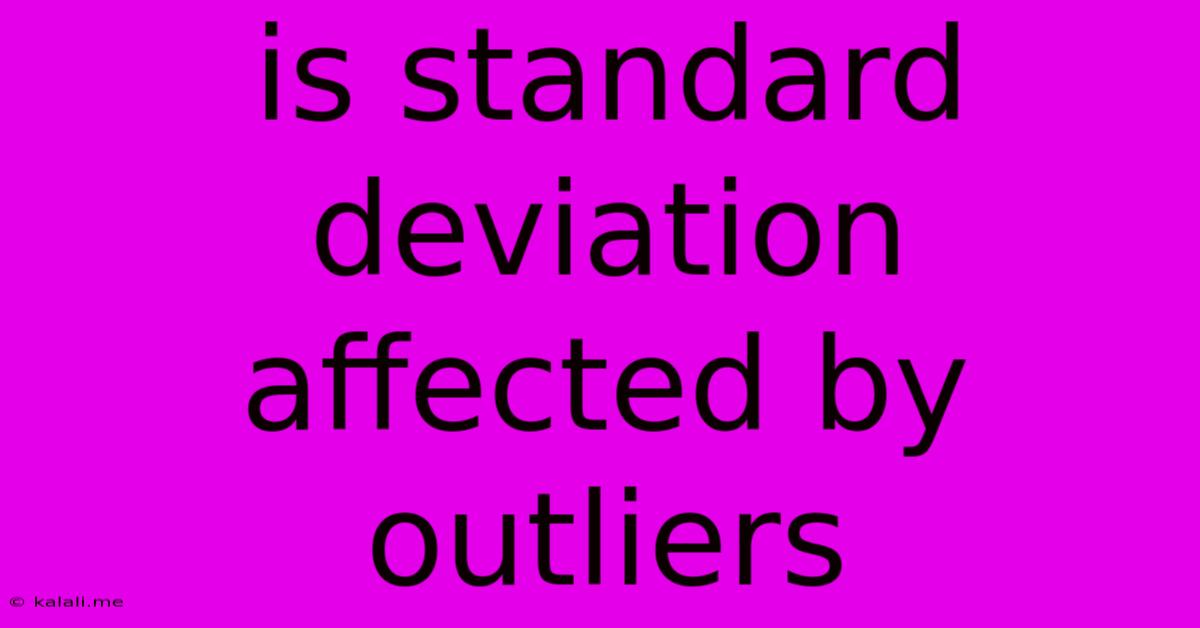Is Standard Deviation Affected By Outliers
Kalali
May 09, 2025 · 4 min read

Table of Contents
Is Standard Deviation Affected by Outliers? A Comprehensive Guide
Meta Description: Discover how outliers significantly impact standard deviation, a crucial measure of data dispersion. Learn about robust alternatives and effective outlier handling techniques. This guide clarifies the relationship between outliers and standard deviation, helping you analyze data more accurately.
Standard deviation is a fundamental statistical measure that quantifies the amount of variation or dispersion in a dataset. It essentially tells us how spread out the data points are from the mean (average). But what happens when our data contains outliers – those extreme values that lie significantly far from the other data points? The short answer is: yes, standard deviation is heavily affected by outliers.
This article delves deeper into this relationship, explaining why outliers influence standard deviation, what the implications are, and what alternative measures you can use when dealing with datasets containing such extreme values.
Understanding Standard Deviation
Before we explore the impact of outliers, let's quickly recap what standard deviation represents. It's calculated by finding the average of the squared differences between each data point and the mean. The square root of this average is then taken, resulting in the standard deviation. A higher standard deviation indicates greater variability, while a lower standard deviation suggests the data points are clustered closely around the mean.
How Outliers Inflate Standard Deviation
Outliers exert a disproportionate influence on standard deviation because of the squaring process involved in its calculation. The larger the distance between an outlier and the mean, the more it contributes to the sum of squared differences. This ultimately leads to a larger standard deviation, potentially misrepresenting the true variability within the majority of the data. Essentially, a few extreme values can artificially inflate the standard deviation, making it appear as if the data is much more spread out than it actually is for the majority of data points.
Implications of Outlier Influence on Standard Deviation
An inflated standard deviation due to outliers can lead to several problems in data analysis:
- Misleading conclusions: A larger standard deviation might suggest higher variability than actually exists, leading to incorrect inferences about the data's characteristics.
- Inaccurate predictions: Statistical models relying on standard deviation, such as regression analysis, can produce inaccurate predictions if the standard deviation is skewed by outliers.
- Compromised hypothesis testing: Outliers can affect the results of hypothesis tests that rely on standard deviation, potentially leading to incorrect conclusions about the significance of observed effects.
Dealing with Outliers: Robust Alternatives to Standard Deviation
When outliers are present and significantly impacting your analysis, consider these alternatives to standard deviation:
-
Median Absolute Deviation (MAD): MAD measures the average absolute deviation from the median, rather than the mean. The median is less sensitive to extreme values than the mean, making MAD a more robust measure of dispersion.
-
Interquartile Range (IQR): The IQR is the difference between the 75th percentile (Q3) and the 25th percentile (Q1) of the data. It focuses on the central 50% of the data, effectively ignoring outliers.
-
Winsorized Standard Deviation: This method replaces extreme values with less extreme values (often, values at the 5th and 95th percentiles) before calculating the standard deviation, reducing the outlier's effect.
-
Trimmed Standard Deviation: This involves removing a certain percentage of the highest and lowest values before calculating the standard deviation.
Identifying and Handling Outliers
Before choosing a robust alternative, it’s crucial to identify and understand the nature of outliers:
- Data errors: Are they simply mistakes in data entry or measurement? Correcting these errors is often the best solution.
- True anomalies: Do they represent genuine extreme events or unusual observations that are part of the natural variability of the phenomenon being studied? If so, you may need to use robust alternatives or consider separate analysis of the outliers.
Techniques like box plots, scatter plots, and Z-score calculations can help identify potential outliers.
Conclusion
In summary, outliers significantly influence standard deviation, potentially leading to inaccurate analyses and misleading conclusions. Understanding this impact is crucial for effective data interpretation. By utilizing robust alternatives to standard deviation and employing appropriate outlier handling techniques, you can gain more accurate insights and make better-informed decisions based on your data. Remember to always investigate the cause of outliers before deciding on an appropriate analytical strategy.
Latest Posts
Latest Posts
-
108 Cm In Inches And Feet
May 09, 2025
-
What Is 100 Milliliters Equivalent To
May 09, 2025
-
Whats A 11 Out Of 15
May 09, 2025
-
How Much Baking Soda To Raise Ph In Pool Calculator
May 09, 2025
-
How Many Millimeters Is 2 1 4 In
May 09, 2025
Related Post
Thank you for visiting our website which covers about Is Standard Deviation Affected By Outliers . We hope the information provided has been useful to you. Feel free to contact us if you have any questions or need further assistance. See you next time and don't miss to bookmark.